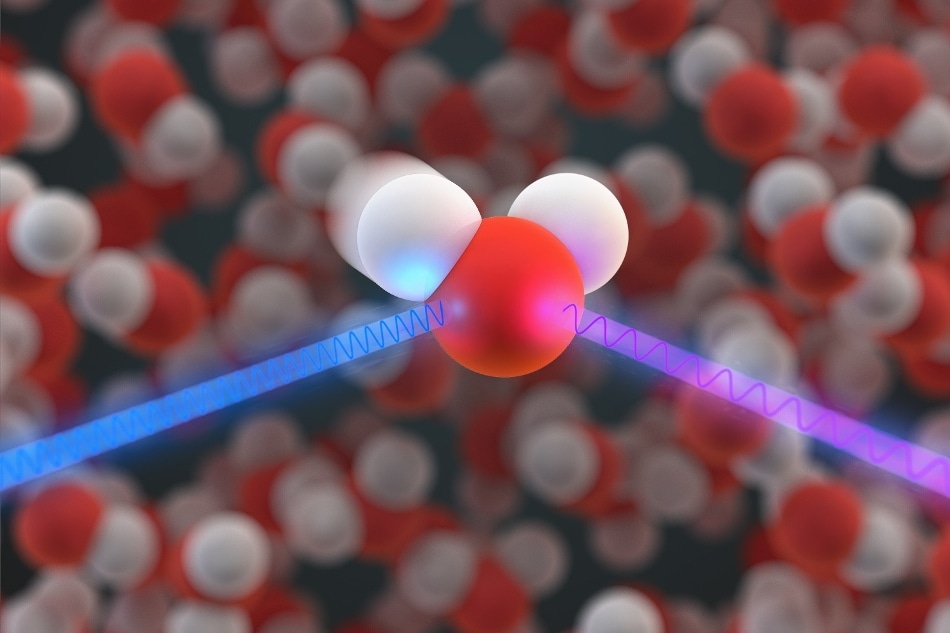Feb 21 2019
A few scientists presumed that water comprises of a mixture of two phases at ambient conditions, to explain the known anomalous behavior of water. But this is not the case as shown by new X-ray spectroscopic analyses at BESSY II, European Synchrotron Radiation Facility (ESRF), and Swiss Light Source.
 Water molecules are excited with X-ray light (blue). From the emitted light (purple) information on H-bonds can be obtained. (Image credit: T. Splettstoesser/HZB)
Water molecules are excited with X-ray light (blue). From the emitted light (purple) information on H-bonds can be obtained. (Image credit: T. Splettstoesser/HZB)
The molecules of water, at ambient temperature and atmospheric pressure, develop an unstable network with an average of 1.74% ± 2.1% donor and acceptor hydrogen bridge bonds per molecule, resulting in a tetrahedral coordination between nearest neighbors.
At ambient conditions, water is the matrix of chemistry and life and shows various anomalous properties. From the time of Wilhelm Conrad Röntgen, it has been argued that two different phases coexist in liquid water, competing with the alternative view of the single-phase liquid in an unstable hydrogen bonding network—the continuous distribution model. Over time, X-ray spectroscopic techniques have been repeatedly performed in agreement with Röntgen’s hypothesis.
Three Light Sources Involved
An international research team, led by Prof. A. Föhlisch from Helmholtz-Zentrum Berlin and the University of Potsdam, performed quantitative and high-resolution X-ray spectroscopic multi-method examinations and analysis to focus on these diverging views at the three light sources, namely, BESSY II, ESRF, and Swiss Light Source.
Result: Tetrahedral Coordination
They showed that it is possible to explain completely and consistently the X-ray spectroscopic observables using continuous distribution models of near-tetrahedral liquid water at ambient conditions with 1.74% ± 2.1% donated and accepted H-bonds for each molecule. Furthermore, the complete phase diagram of water shows a good correlation with second shell coordination, for instance, and the effect of ultrafast dynamics related to X-ray matter interaction is isolated and quantified.
Continuous Distribution Model Holds True
Can these X-ray spectroscopic results on water at ambient conditions be used now to resolve the heavily contended question of the occurrence of a second critical point in the so-called “no man’s land” of supercooled water? This hypothesized second critical point is theoretically based on the extension of the established low- and high-density amorphous ice phases into so-called low- and high-density liquid phases along a Widom line at which the second critical point emerges as the extrapolated divergence of supercooled and stable water’s thermodynamic response functions around -45 °C at normal pressure.
According to the physics of critical fluctuations, it is understood that well above a critical point, the state of matter must be considered as homogeneous. Huge and incipient fluctuations are permitted while drawing closer to the phase boundary and the critical point. Although how close one has to approach it in energy and on what time scale to sense the divergence is not completely answered, it is assumed that according to the observations in the solid-state physics, there are two-phase effects.
Despite the existence of the alleged second critical point at -45 °C and atmospheric pressure, the ambient conditions of liquid water in equilibrium would possibly be far away in temperature. Therefore, the fluctuating continuous distribution model of near-tetrahedral liquid water at ambient conditions is valid irrespective of whether or not the second critical point of water in the supercooled region exists.